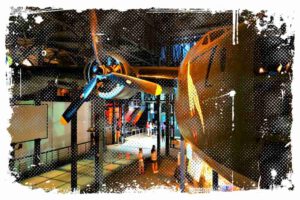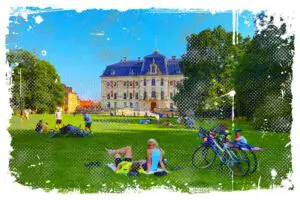The oldest evidence of human presence in the Bialowieza Forest dates back 4,500 years ago, to the Neolithic Age. There were two villages from this period discovered near the village of Rudna as early as in 1923. The population who lived in the area was active in hunting and animal husbandry, they also harvested ore and burned charcoal needed for iron smelting.

The forest resources were thus severely depleted, which resulted in a temporary leave of the Forest area by the resident population. It allowed the forests to regenerate.
It was Dr. Hugo Conwentz, a Gdansk botanist and the founder of the conservation movement, who first proposed the creation of the Bialowieza National Park in 1916.
Botanists and foresters worked hard to establish the Forestry Department in 1921, and later the Forest Inspectorate with its restricted zones in the Bialowieza Forest. The Bialowieza Forest was placed under strict protection in 1929. Eventually, in 1932, the Bialowieza National Park was established and in 1947 it was restored to its original name.
↳ PRO TIP: Do you like traveling? Then before you buy any ticket or book an attraction, check if it's available in this worldwide Viator Database. You may save a lot of money and time. No need to thank me :)
In 1996, the area of the park was expanded to 10,502 hectares, and a buffer zone with a hunting ban was created around the park.
If you are interested in Poland’s sites, you may also want to read this article from which you can learn the location of other attractions nearby: Exploring Poland’s Cultural Riches: A Guide to UNESCO Cities
Bialowieza National Park – Key Information
The Bialowieza National Park is home to unique species of animals – fish, amphibians, reptiles, birds and mammals, as well as invertebrates: spiders, non-scorchers, mollusks, gastropods, protozoa, wrigglers, insects and mites. According to estimates, the fauna of the Bialowieza National Park is currently recognized at only 50%.
Rare plants such as Iris sibirica, Arnica montana and Viola uliginosa grow in the Bialowieza Forest. There is a large amount of dead wood in the Bialowieza National Park – it provides a habitat for fungi, bacteria and invertebrates, including some species found nowhere else.
Animals and Vegetation
Bialowieza National Park is home to the world’s largest wild population of bison – several hundred of them. In 1992, UNESCO extended the status of the Bialowieza National Park to include a part of the Belarusian National Park, which is under strict protection.
Plants
The flora in the park includes 809 species of vascular plants and almost 200 species of mosses. In addition, there are more than 3,000 spore-bearing plants and fungi as well as 283 species of lichens. Particularly noteworthy are Siberian scythe, mountain arnica, Viola uliginosa, Neottia cordata and Vaccinum microcarpon.
Animals
The animal kingdom is incredibly diverse, with over 8,000 different species of invertebrates, 32 species of fish, 11 species of amphibians, 7 reptiles, about 120 breeding birds and 52 mammals. Examples of some of these creatures include the monochamus, Osmoderma eremita and Pytho kolwensis, the butterflies Aglia tau and Colias palaeno, as well as the owl, three-toed and white-backed woodpecker, beaver, deer, roe deer, wild boar, lynx, otter, moose, coot, Eurasian water shrew and, above all, the bison.
Before the First World War, there were more than 700 bison in the Bialowieza Forest. Unfortunately, the war led to their complete extinction, with the last one dying in 1919. To restore them, a game reserve was founded in 1929 and animals from the zoo have been moved to it. Currently, there are about 950 bisons in the entire forest area, which can be happily observed in the Bison Reserve.
Trails to Explore
The Hwoźna Conservation Area is located in the north of the park. This area is largely dedicated to hiking and biking. It offers more than 20 km of hiking and 14 km of bicycle trails, where communing with nature is facilitated by towers and viewpoints, numerous footbridges and hiking shelters.
These trails are available to tourists free of charge and without a guide. There are three ways to get to this area: from the side of Narewka, from the settlement of Zamosze and from the village of Masiewo. There are parking spaces, shelters and large maps with detailed tourist information on the trails.
Bicycle Routes
These begin in Narewka, where there is a bicycle rental shop. Moreover, in the Narewka valley by the Kosy Most wilderness, there is an observation platform built for watching wild animals. You can see bison descending into the brogue with hay from there, among other things.
Hiking Trails
The Green Trail, also known as the „Wolf Trail”, offers an adventurous 11-kilometer journey starting from the outskirts of Zamosze to Kosy Most. The trail is a journey of discovery. It passes through swampy forests, an open-air museum of narrow-gauge railways, former timber depots and an inanimate natural monument.
The Red Trail, also known as the „Groszec Wilderness Trail”, is a 5.5 km loop. It starts in the village of Masiewo and takes you around the Groszec Wilderness. You can admire the old Lutheran cemetery, see the traces of a charcoal kiln and enjoy the open-air museum of the narrow-gauge railway in the forest. Pine and spruce forests with many clearings and peat bogs make this reserve a real gem of the Bialowieza Forest.
The Black Trail, also known as the „Tsar’s Trail”, is a scenic 4 km route that begins at the depot in front of Kosy Most. Through the valley of the Narewka River and its forests of pine and alder trees, this path leads along a road built in the time of the Tsars. There is a lookout tower with a view of the Narewka Valley, as well as lookout points and footbridges. It is considered to be the most beautiful of all the trails.
The Most Important Attractions of Bialowieza Park
Bison Reserve
Bialowieza National Park boasts many stunning sights, but its most popular attraction is the Bison Reserve. Visitors can see a variety of wildlife, including bison, Polish tarpan horses, moose, deer, roe deer, wild boar, bison-cattle hybrids, wolves, and lynx, in their natural habitat, located off the Hajnówka-Bialowieza highway. Schoolchildren can take field trips to the reserve, which also serves as an educational center.
Location
Bison Show Reserve is located just minutes from Bialowieza city. To get to the reserve, look for a sign with the iconic bison symbol. If you feel adventurous, you can walk several kilometers from Bialowieza towards Budy and cross „Żubr’s footbridge”. It is a pleasant walk of about 4 km to the reserve. There is a large parking lot at the entrance to the reserve for your convenience.
Google Maps Location: here
Visiting Hours
The Bison Show Reserve’s visiting hours are as follows:
- During peak season (April 16th to October 15th), it’s open daily from 9:00 AM to 5:00 PM.
- In the off-season (Tuesday to Sunday), you can visit from 8:00 AM to 4:00 PM.
Ticket Prices (2023):
- Regular: 20 zł
- With Discount: 12 zł
Nature and Forestry Museum
The Natural History and Forestry Museum in Bialowieza is a popular destination. It’s one of the most modern museums of its kind in Poland. Visitors can observe a range of displays, such as diverse communities of plants and animals found in the woods, aquatic life, and the many different critters that live below the surface. Additionally, the museum features displays of predators and avian species that live in the forest, as well as exhibits of humankind’s effect on the surrounding environment.
The museum also features temporary exhibitions of photography, art, and sculpture. The light and sound recordings of the forest create a vibrant atmosphere.
Museum Location
Muzeum Przyrodniczo-Leśne im. prof. J. Miklaszewskiego
Park Pałacowy 11
17-230 Bialowieza
Parking
I suggest you park your car in the large parking lot just in fron of the entrance to the Palace Park (Park Pałacowy). A few minutes’ walk on a wooden platform will take you along tranquil ponds and a picturesque park avenue.
Parking Location: Click Here
Visiting Hours:
- Peak Season (April 16th to October 15th): Mon-Fri, 9:00 AM to 4:30 PM; Sat-Sun, 9:00 AM to 5:00 PM.
- Off-Season: Tue-Sun, 9:00 AM to 4:00 PM.
Ticket Prices:
- The ticket is free of charge for children up to 4 years of age, for accompanying persons of organized groups and for residents of the communes of Bialowieza and Narew.
- Regular tickets range from 13 to 20 PLN, while concessionary tickets cost between 9 and 16 PLN.
Palace Park in Bialowieza
Bialowieza’s palace park is amazing. It was created at the end of the 19th and the beginning of the 20th century. It covers an area of almost 0.5 square kilometers and is planted in the classic English garden style. There are trees from all over the world, including Canadian Christmas trees and red oaks, and on the hill you can find ancient 300-year-old live oaks.
The park also contains the oldest preserved building in Bialowieza – a wooden manor house from 1845 – as well as other buildings from the time when the Tsar resided in the area, such as the stables and the palace gate. Finally, there are two ponds located in the southern part of the park.
There is an obelisk with Polish and German inscriptions commemorating the capture of August III and his partner during a hunting expedition in 1753. The palace park can be explored by walking along a circular path with information boards that provide details about plants, objects, and the history of the park and the village.
The Nature Education Center offers a variety of nature-based classes for children and young adults. These nature classes foster in the younger generations the desire to protect and preserve the environment.
You can purchase tickets to the Bialowieza National Park’s attractions at the following locations:
- Tourist Information Point
- Ticket offices at the Natural Forest Museum and the Bison Reserve
- Hunting House
Bibliography
- https://www.bpn.com.pl/
- https://pl.wikipedia.org/wiki/Bia%C5%82owieski_Park_Narodowy
- http://www.msw-pttk.org.pl/dokumenty/parki_narodowe/biapn.html



